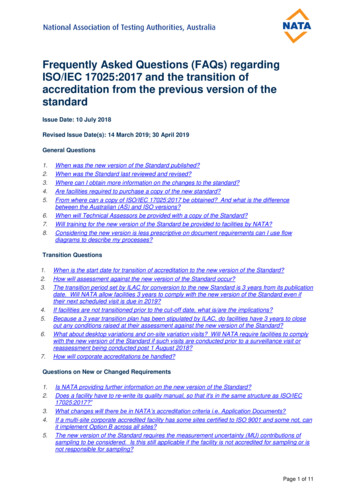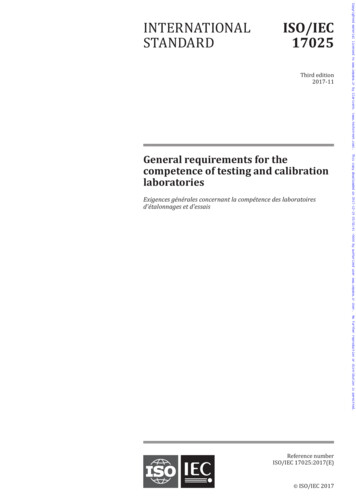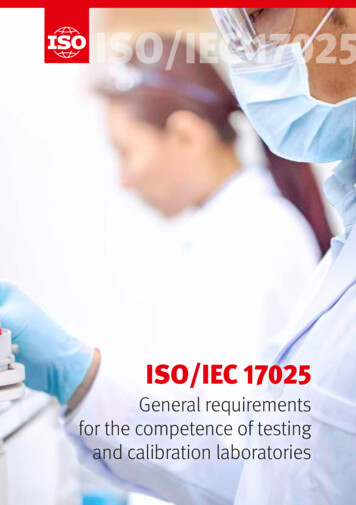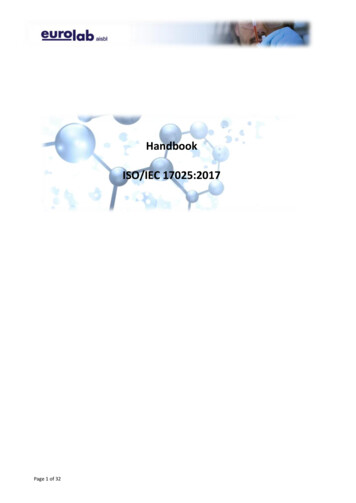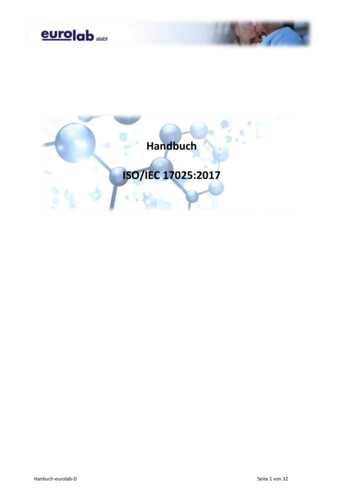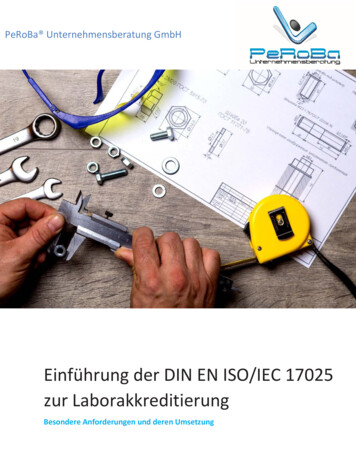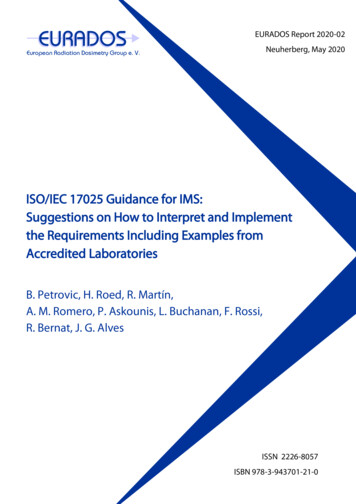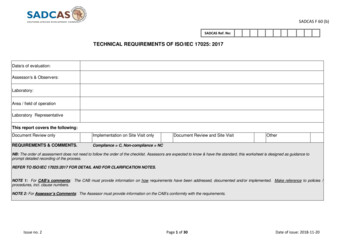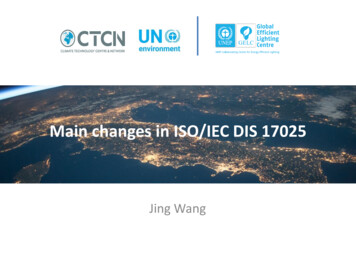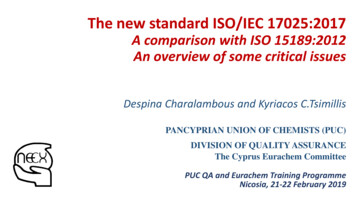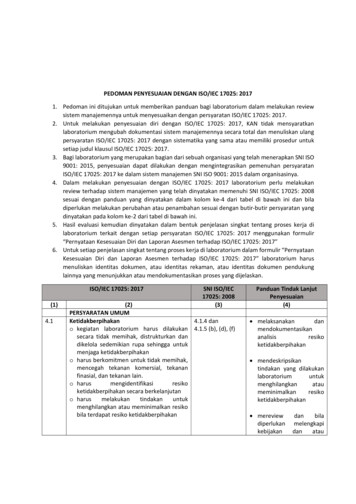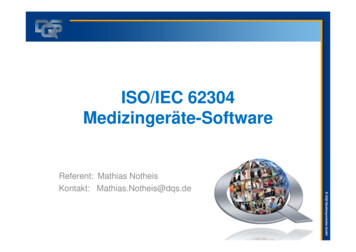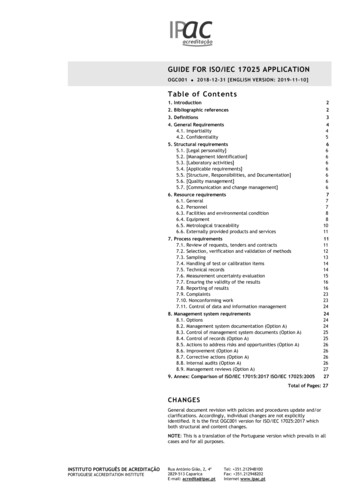
Transcription
GUIDE FOR ISO/IEC 17025 APPLICATIONOGC001 2018-12-31 [ENGLISH VERSION: 2019-11-10]Table of Contents1. Introduction22. Bibliographic references23. Definitions34. General Requirements4.1. Impartiality4.2. Confidentiality4455. Structural requirements5.1. [Legal personality]5.2. [Management Identification]5.3. [Laboratory activities]5.4. [Applicable requirements]5.5. [Structure, Responsibilities, and Documentation]5.6. [Quality management]5.7. [Communication and change management]666666666. Resource requirements6.1. General6.2. Personnel6.3. Facilities and environmental condition6.4. Equipment6.5. Metrological traceability6.6. Externally provided products and services7778810117. Process requirements7.1. Review of requests, tenders and contracts7.2. Selection, verification and validation of methods7.3. Sampling7.4. Handling of test or calibration items7.5. Technical records7.6. Measurement uncertainty evaluation7.7. Ensuring the validity of the results7.8. Reporting of results7.9. Complaints7.10. Nonconforming work7.11. Control of data and information management1111121314141516162323248. Management system requirements8.1. Options8.2. Management system documentation (Option A)8.3. Control of management system documents (Option A)8.4. Control of records (Option A)8.5. Actions to address risks and opportunities (Option A)8.6. Improvement (Option A)8.7. Corrective actions (Option A)8.8. Internal audits (Option A)8.9. Management reviews (Option A)242424252526262626279. Annex: Comparison of ISO/IEC 17015:2017 ISO/IEC 17025:200527Total of Pages: 27CHANGESGeneral document revision with policies and procedures update and/orclarifications. Accordingly, individual changes are not explicitlyidentified. It is the first OGC001 version for ISO/IEC 17025:2017 whichboth structural and content changes.NOTE: This is a translation of the Portuguese version which prevails in allcases and for all purposes.INSTITUTO PORTUGUÊS DE ACREDITAÇÃOPORTUGUESE ACCREDITATION INSTITUTERua António Gião, 2, 4º2829-513 CaparicaE-mail: acredita@ipac.ptTel: 351.212948100Fax: 351.212948202Internet www.ipac.pt
GUIDE FORISO/IEC 17025APPLICATIONOGC0012018-12-311. IntroductionThis document provides guidance for application of ISO/IEC 17025:2017 (also referred to as ISO/IEC 17025or as the standard). It is intended to be used by IPAC’s assessors and accredited and applicant laboratoriesIt includes interpretations, explanations and examples of implementation considering, among others,documents prepared by EA and ILAC as well as the experience accumulated by laboratories and IPAC. Thecontent considered the inputs from interested parties, notably through the Laboratory accreditationTechnical Committee (CTaL).The guide is of general application (for all types of laboratory activities - testing, calibrations andassociated sampling) and is structured in accordance with the clauses of ISO/IEC 17025 - it should be notedthat it does not includes the standard text and SHALL always be used in conjunction with it). It contains: Interpretative notes (signalized with expressions as “It is interpreted” and “It is considered”; Examples of fulfilment of the requirements (signalized with expressions as “Can/may” and “Forexample/E.g.”); Non-binding recommendations (signalized with expressions as “It is recommended” and “Should”); Explicit accreditation criteria, or contractual additional requirements, both mandatory, signalizedwith “Shall”.2. Bibliographic referencesThe following documents are the most relevant to the application of this document:Page 2 of 27 DRC001 - General Regulation for Accreditation; DRC002 - Regulation for the Accreditation Symbols; DRC005 - Procedure for Accreditation of Laboratories; OGC002 - Guide for Accreditation of Chemical testing Laboratories; EA-4/02 - Expression of the uncertainty of measurements in calibration; EA-4/14 - The selection and use of reference materials; EA-4/16 - EA guidelines on the expression of uncertainty in quantitative testing; ILAC- G8 - Guidelines on assessment and reporting of compliance with specification; ISO/IEC 17065 - Conformity assessment -- Requirements for bodies certifying products, processes andservices ISO/IEC 17025 - General requirements for the competence of testing and calibration laboratories; ISO/IEC 17000 - Conformity assessment -- Vocabulary and general principles; ISO 9000 - Quality management systems - Fundamentals and vocabulary; ISO 10012 - Measurement management systems - Requirements for measurement processes andmeasuring equipment; ISO 10015 - Quality management -- Guidelines for training; ISO 19011 - Guidelines for auditing management systems; ISO 31000 - Risk management - Guidelines; ISO/TR 10013 - Guidelines for quality management system documentation; ISO Guide 30 - Reference materials - Selected terms and definitions; ISO Guide 31 - Reference materials - Contents of certificates, labels and accompanyingdocumentation; ISO Guide 33 - Reference materials - Good practice in using reference materials; ISO Guide 35 - Reference materials - Guidance for characterization and assessment of homogeneityand stability; ISO 17034 - General requirements for the competence of reference material producers;
GUIDE FORISO/IEC 17025APPLICATIONOGC0012018-12-31 ISO/IEC 17043 - Conformity assessment - General requirements for proficiency testing; ISO/IEC Guide 98-3 - Uncertainty of measurement -Part 3: Guide to the expression of uncertainty inmeasurement (GUM); ISO/IEC Guide 99 - International vocabulary of metrology - Basic and general concepts and associatedterms (VIM); JCGM 106 - Evaluation of measurement data - The role of measurement uncertainty in conformityassessment.3. DefinitionsFor the purposes of this document, and in addition to the definitions in ISO/IEC 17025, the followingdefinitions are adopted and/or referenced:Internal Calibration: Calibration performed on the premises of the laboratory or organization to which itbelongs, with its personnel and equipment and covered by the same management system according toISO/IEC 17025.Request (consultation): Survey made by a potential client about the possibilities of providing laboratoryservices. Examples: budget requests, public consultations, etc.Maintenance: set of operations intended to maintain (preventive maintenance) or to reset (correctivemaintenance) the equipment in its correct working condition, namely by replacement or inspection ofparts, cleaning, etc.Standard method: A test method that follows operations stated in a standard or equivalent normativedocument drawn up by a standardization body or a sectoral body comprising representatives of thetechnical sector. These methods are assumed to have been duly validated, are subject to periodic updatingand are recognized by the national and international laboratory community. Examples: NP, EN, ISO, UNE,NF, etc.; sectoral standard ASTM, TAPPI, SMEWW, OIML, AOAC, etc. Methods issued or recognized byscheme owners1 and public authorities, where relevant, are considered as standard methods.Non-standard method: This category covers methods not included in the definition of standard method,namely: Methods coming from adaptations or modifications of standard methods; Methods fully developed by the laboratory.Opinion and interpretation: is the result of the process by which the applicability of the result of a test orcalibration can be extended. The inferences concerned are made on the basis of the result and theknowledge and professional judgment of persons specifically authorized for that purpose. Opinions andinterpretations SHALL be technically robust and supported by unambiguous evidence. Information related tothe results, that are an integral part of the results and which are essential for their interpretation are notconsidered to be opinions or interpretations.Tender (proposal): response given by a laboratory to a request (consultation) with the purpose celebrate acontract to perform the related laboratory activities and/or servicesContract: documented agreement for providing testing, calibration and sampling services.DRC001 contains definitions of cause analysis, correction and corrective action.VIM contains, namely, the following definitions: calibration (see also DRC005), verification, uncertainty,error, correction, adjustment, traceability, standard (and related terms), reference material and certifiedreference material (for these last two definitions see also ISO 17034 and the related ISO/REMCO guides)ISO/IEC 17000 includes the following definitions: accreditation, multilateral agreement, testing (see alsoDRC005), sampling (see also DRC005), and 1st, 2nd or 3rd party.ISO 9000 contains, namely, the following definitions: non-conformity, correction and corrective action.In this document the following abbreviations are used:1Page 3 of 27 BIPM - Bureau International des Poids et Mesures (www.bipm.org) CIPM – Comité International des Poids et Mesures (www.bipm.org) EA - European cooperation for Accreditation (www.european-accreditation.org) EPTIS – European PT Information System (www.eptis.bam.de)DRC005 includes the definition of sector scheme.
GUIDE FORISO/IEC 17025APPLICATIONOGC0012018-12-31 IAEA - International Atomic Energy Agency (www.iaea.org) ILAC - International Laboratory Accreditation Cooperation (www.ilac.org) IPAC - Instituto Português de Acreditação (www.ipac.pt) ISO - International Organization for Standardization (www.iso.ch) LNM – National Metrology Laboratories NIST - National Institute for Standards and Technology (www.nist.gov) OIML – International Organization of Legal Metrology (www.oiml.org) VIRM – Virtual Institute for Reference Materials (www.virm.net)4. General Requirements4.1. Impartiality4.1.1 [Principle of impartiality]4.1.2 [Management commitment]4.1.3 [Responsibility and absence of undue pressures]4.1.4 [Identification of risks to impartiality]Situations that may threaten the impartiality of the laboratory or its personnel SHALL be considered as risksto the impartiality of the laboratory.Threats to impartiality can be categorized as follows2:(a) self-interest threats: threats arising from a person or body acting in their own interest (financial,material or immaterial benefit) e.g. excessive reliance on a contract, fear of losing a client or becomingunemployed;(b) self-assessment threats: threats that arise from a person or body evaluating their own work, e.g.evaluation of products for which they have carried out consultancy activities;(c) advocacy threats: threats arising from the involvement of a person or body in the settlement of disputesinvolving their client organizations;d) Threats of familiarity (or trust): threats that arise from a person or body that is too familiar or confidentin the people performing the activity to objectively question and evaluate them;(e) threats of intimidation: threats that arise from a person or body with the perception of being coerceddirectly or indirectly, e.g. the threat of being replaced or reported to a superior;f) Threats of competition: threats that arise from a person or body that evaluates products or services fromits competitors.The laboratory MUST have a mechanism for identifying the risks associated with its activities, itsrelationships, and the relationships of its personnel, using for example, organizational diagrams or othermeans.For example, the following situations may be considered as risks to impartiality. Risks associated with laboratory’s activities:-Undue pressure caused by commercial objectives;-Requests for delivery of results with priority;-Reduced number of customers; Risks associated with laboratory’s relationships:2Text adapted from QS-CAS-PROC / 33 (Common Elements In ISO / CASCO standards) as of the date available 853493/8853511/8853520/15758504/ QS-CAS-PROC33 Common Elements in ISO CASCO Standards.pdf? Nodeid 17295497 & vernum -2.Page 4 of 27
GUIDE FORISO/IEC 17025APPLICATIONOGC0012018-12-31 -The laboratory carries out conformity assessment activities for products whoseresponsibility for the design, manufacture, sale, maintenance or repair is of the of theentity to which the laboratory belongs to;-The entity to which the laboratory belongs provides technical consulting services such asproject design and validation of their suitability based on tests performed by thelaboratory, with co-responsibility in obtaining results;-The laboratory assesses the compliance of customer products that purchase otherproducts or services to the laboratory (or the entity to which it belongs);-The laboratory assesses the compliance of equipment used in business transactions inwhich the laboratory (or the entity to which it belongs) is an interested party.-Complaints from customers or over-familiarity between the laboratory and customers;-Relationship with regulatory entities;Risks associated with laboratory’s staff relationships:-Accumulation of duties and direct responsibilities of staff, whether performed inside oroutside the laboratory or of the entity, individually or on behalf of others;-Self-interest (e.g. over-reliance on a contract, fear of losing a job or family relationshipsbetween different hierarchical positions).The laboratory SHALL identify events that may impact the reassessment of risk analysis to its impartiality.Any change to the initially considered situations SHALL be promptly reassessed to confirm if the initiallyidentified impartiality risks3 maintain.The one who performs, reviews or approves laboratory activities (testing, calibration, sampling) on aparticular object SHALL NOT have been, or involved in, the design, production, supply, installation, serviceand maintenance of that object. There may be provisions, however, that minimize the associated risks toan acceptable level, such as the use of uncharacterized samples or the definition of compassionate leave.4.1.5 [Treatment of risks to impartiality]For each impartiality risk, the laboratory SHALL define whet
ISO Guide 31 - Reference materials - Contents of certificates, labels and accompanying documentation; ISO Guide 33 - Reference materials - Good practice in using reference materials; ISO Guide 35 - Reference materials - Guidance for characterization and assessment of
